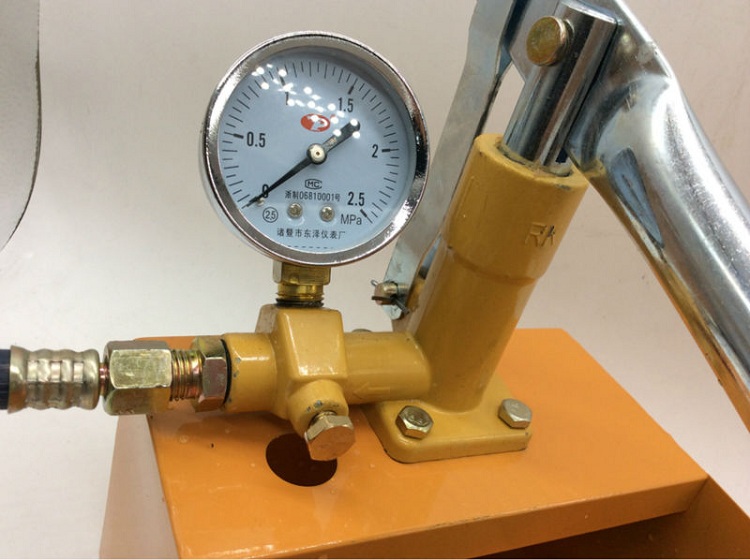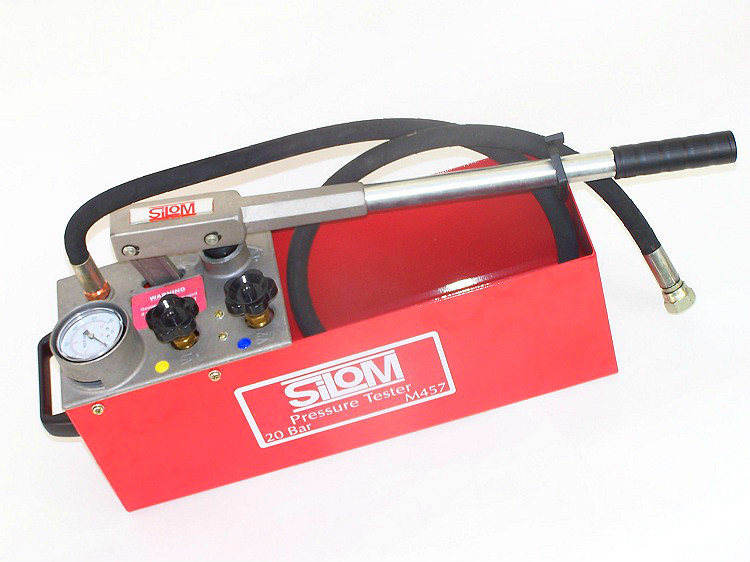A manual hydraulic press or a pump for crimping pipelines is used to carry out hydraulic tests of communications, as well as various containers. The medium can be any: water, antifreeze, hydraulic oil, etc. The crimping apparatus, as a rule, is equipped with a pressure gauge that measures pressure and a hose. A hose is required to connect the instrument to the test system.
Content
- 1 Scopes of use of a manual hydraulic press
- 2 Advantages and disadvantages of a manual hydraulic press
- 3 Features of a manual crimping machine
- 4 General device for manual crimping pump
- 5 The principle of operation of a manual hydraulic press
- 6 How to choose a crimping machine
- 7 How to make a crimping machine with your own hands?
Scopes of use of a manual hydraulic press
Such devices are used in order to determine the integrity of a particular communication. Moreover, the verification can take place both on a separate site and throughout the system. Consider the main communications that are checked using a pressure pump:
- water pipes;
- heat pipes;
- sewer pipelines.
Cases of using this device may be as follows:
- hydraulic check is carried out before putting into operation the newly installed communication. Depending on what material the pipeline is made of, the main vulnerabilities in the system are determined. Plastic communications are often mounted using special connecting elements - fittings, and individual sections of metal structures are joined by welding or thread. Connection points, regardless of the communication material, are considered to be prone to leaks;
- hydrotesting is also performed to identify potential weak points in the system. Places that are more likely to leak are easy to spot. Using a manual hydraulic press, a pressure in the system under test is created that will be higher than the maximum working pressure. If the pipeline withstands high pressure for a certain period of time, we can conclude that it will serve for quite a while at ordinary pressure;
- in addition, such checks are required after the repair of communication. This is necessary in order to check how well the system was repaired;

Hydrochecking is carried out regularly, it allows you to identify problems in the system and prevent an emergency
Important! After installing new equipment or other auxiliary components, it is also necessary to conduct hydraulic testing of pipelines.
- there are preventive measures that are aimed at identifying the degree of wear of pipes in a particular communication. Especially periodic hydraulic checks are relevant for metal pipelines. This is due to the fact that over time, such structures are exposed to corrosive influences, which lead to the deterioration of their walls.
Advantages and disadvantages of a manual hydraulic press
Like any other product, a manual hydraulic press has its own advantages and disadvantages. To begin, consider the main advantages of this device:
- mobility. The device is quite compact, which allows it to be transported to any necessary place and to carry out hydraulic tests on site;
- during normal use it has a rather long service life;
- if necessary, it can be repaired and used further for its intended purpose;
- the operation of such a device is completely safe;
- hydraulic presses for crimping pipelines are quite cheap, which is often a determining factor.
The disadvantages of a manual hydraulic press for crimping pipelines include:
- the device does not have a restriction valve;
- when the device is functioning, it is necessary to constantly monitor it;
- achieving the desired pressure in the system is a rather lengthy process when using a hand-held device;
- a handheld device is less versatile than its electrical counterpart;
- physical effort is required.

The compact dimensions of the handheld device allow you to carry out work in the domestic environment without any problems
Features of a manual crimping machine
Almost all models of crimping devices are self-priming. This means that they can absorb fluid. To do this, the hose, which is part of the crimp design, is lowered into the injected fluid. In order to simplify this process as much as possible, many models are equipped with a special tank.
Helpful information! The performance indicators of such devices, as a rule, are not more than 50 MPa (500 atmospheres).
The most compact manual models are used for quick pressure testing as well as tightness in various systems. In addition, there are manual crimping machines that are used in various industries. They check various industrial equipment (for example, boilers). Such checks are carried out in three stages:
- At the first stage, preliminary filling of the tested pipeline or other object is performed.
- Next, a hydraulic press is used to pressurize the pipes with a hand hydraulic press.
- At the last stage, a decrease in pressure in the pipeline is monitored. Pressure control is carried out using a manometer or visually (if there are visible leaks).
Hand models are quite popular, since their use is practically unlimited. They can be used to organize testing of business networks, as well as to test communication in a multi-storey building.
It is worth noting one important advantage of using a hand press - a low level of error. This advantage is due to the fact that the press operator himself adjusts the pressure indicator during the pipeline test. The hoses of such devices at the production stage are equipped with a protective braid, which eliminates the possibility of expansion of the hose under pressure.
General device for manual crimping pump
The manual device consists of the following elements:
- a control tool (handle), which is necessary to pressurize the system;
- capacity with liquid;
- pressure gauge;
- hose - for connection to the test pipe;
- body.
Manual hydraulic presses are made, as a rule, of steel. In some cases, high-strength composites act as a manufacturing material. If you decide to purchase a manual crimping machine, it is recommended to pay attention to its weight. This is due to the fact that for such a device there are different operating conditions and some of them have limitations on this indicator. The most common are manual crimpers, which weigh from 5 to 7 kg.
In addition, all manual models are divided into three types:
- piston (single-stage and two-stage);
- lamellar-rotor;
- membrane.
The principle of operation of a manual hydraulic press
In order to carry out such an event as a hydraulic test of the pipeline, it is first necessary to fill the closed section with liquid. After the fluid reaches its maximum circuit, the operator should begin to monitor pressure readings.
As a rule, the crimping event lasts several hours. From the beginning to the end of the process, it is necessary to ensure the normal functioning of the manual hydraulic press. After the desired time period is passed, a repeated measurement of pressure in the test system is performed. The final metering is compared with the original data and based on this, the integrity of the system is determined.
Note! The range of crimping machines is incredibly wide. The choice of a particular model depends on which network will be tested. For each communication, you need to select a device with a suitable pressure range.
If after testing the preliminary measurement of pressure does not coincide with the finish, then in this case, you can conduct a second test or immediately begin to repair the communication.
How to choose a crimping machine
Today there are a huge number of different models of crimping machines. Manual hydraulic crimping machines are produced by many well-known companies. When choosing them, it is recommended to pay attention to two important factors:
- test communication volume;
- how often checks will be made.
Manual models of hydraulic presses are much simpler, from a structural point of view, and also are much cheaper than electrical counterparts. However, the simplicity of design and manual control also affects the rate of pressure in the system. Compared to electric presses, manual models pump the required pressure indicators much longer.
The operational time of the device, as well as the accuracy of the test results, depends on the power of the model. Devices with low power stretch the test time, and if there is a leak in the system, this will affect the accuracy of the result. Therefore, for systems with a large volume of liquid, it is recommended to use powerful devices that are capable of performing the necessary work in a short period of time, which will allow you to get the most accurate results.
For a home pipeline, a device that can pass through 2-3 liters of liquid per minute will be quite enough. And hydraulic testing of pipelines requires the use of circulation pumps.
How to make a crimping machine with your own hands?
If necessary, manual crimping can be performed independently. Assembling such a device will require suitable spare parts that can handle the functions of a hand press for crimping pipelines. Old jacks are well suited for these purposes, and a container (preferably a cylindrical shape) will also be required.
The assembly of individual elements is recommended to be carried out by means of threaded connections. In the tank, it is absolutely necessary to make several holes for the measuring device and the hose for draining the liquid. If you wish, you can also assemble an electric crimping machine with your own hands, however, such a machine is unlikely to be highly accurate.









